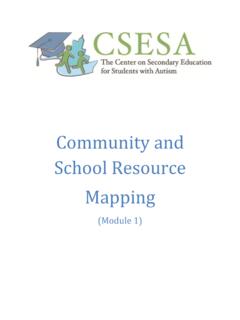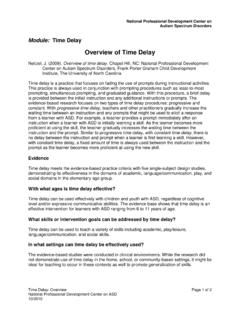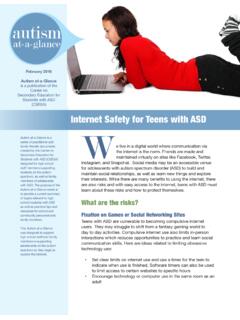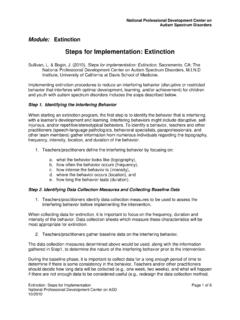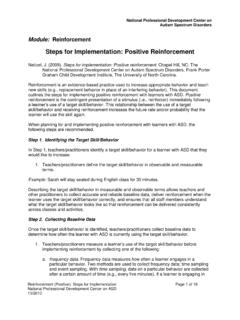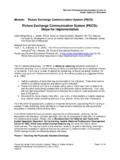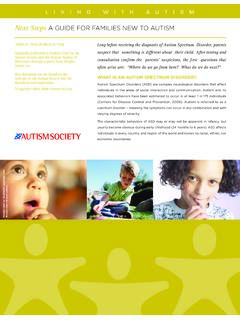Transcription of Overview of Picture Exchange Communication System (PECS)
1 National Professional Development Center on Autism Spectrum Disorders Module: Picture Exchange Communication System (PECS) Picture Exchange Communication System : Overview Page 1 of 3 National Professional Development Center on ASD 10/2010 Overview of Picture Exchange Communication System (PECS) Collet-Klingenberg, L. (2008). Overview of Picture Exchange Communication System (PECS) for children and youth with autism spectrum disorders. Madison, WI: National Professional Development Institute on ASD, The Waisman Center, The University of Wisconsin. The Picture Exchange Communication System (PECS) was developed at the Delaware Autistic Program (DAP) and was designed to teach young children to communicate in a social context (Bondy & Frost, 1994; Frost & Bondy, 2002).
2 Using PECS, learners are taught to give a Picture of a desired item to a communicative partner in Exchange for the item. There are six phases of PECS instruction, with each phase building on the last. The phases are: (1) Teaching the physically assisted Exchange , (2) Expanding spontaneity, (3) Simultaneous discrimination of pictures , (4) Building sentence structure, (5) Responding to, What do you want? and (6) Commenting in response to a question. Evidence Five studies were found to meet the evidence-based practice criteria and serve as the evidence base for PECS. Two of the studies were randomized, controlled group designs, and three were single subject studies demonstrating control through a variety of research designs including multiple baseline, alternating treatments, changing criterion, and withdrawal.
3 With what ages is PECS effective? In the five studies documenting the evidence base for PECS, the youngest child was three years of age, and the oldest was twelve years old. Specific numbers of participants and age data can be found in the evidence base below. What skills or intervention goals can be addressed by PECS? In the evidence-base, Communication , social, and behavior skills were the primary targets for intervention. In what settings can PECS be effectively used? The research evidence suggests that PECS can be used in multiple settings, including schools, homes, and therapy settings. Evidence Base The studies cited in this section provide the basis upon which this practice was determined to meet the NPDC on ASD s criteria as an evidence-based practice.
4 This list is not exhaustive and other quality studies may exist but were not found in our search. National Professional Development Center on Autism Spectrum Disorders Module: Picture Exchange Communication System (PECS) Picture Exchange Communication System : Overview Page 2 of 3 National Professional Development Center on ASD 10/2010 Preschool Charlop-Christy, M. H., Carpenter, M., Le, L., LeBlanc, L. A., & Kellet, K. (2002). Using the Picture Exchange Communication System (PECS) with children with autism: Assessment of PECS acquisition, speech, social-communicative behavior, and problem behavior. Journal of Applied Behavior Analysis, 35(3), 213-231.
5 Ganz, J. B., & Simpson, R. L. (2004). Effects on communicative requesting and speech development of the Picture Exchange Communication System in children with characteristics of autism. Journal of Autism and Developmental Disorders, 34(4), 395-409. Yoder, P., & Stone, W. L. (2006). Randomized comparison of two Communication interventions for preschoolers with autism spectrum disorders. Journal of Consulting and Clinical Psychology, 74(3), 426-435. Elementary Charlop-Christy, M. H., Carpenter, M., Le, L., LeBlanc, L. A., & Kellet, K. (2002). Using the Picture Exchange Communication System (PECS) with children with autism: Assessment of PECS acquisition, speech, social-communicative behavior, and problem behavior.
6 Journal of Applied Behavior Analysis, 35(3), 213-231. Ganz, J. B., & Simpson, R. L. (2004). Effects on communicative requesting and speech development of the Picture Exchange Communication System in children with characteristics of autism. Journal of Autism and Developmental Disorders, 34(4), 395-409. Howlin, P., Gordon, R. K., Pasco, G., Wade, A., & Charman, T. (2007). The effectiveness of Picture Exchange Communication System (PECS) training for teachers of children with autism: A pragmatic, group randomized controlled trial. Journal of Child Psychology and Psychiatry, 48(5), 473-481. Kravitz, R. R., Kamps, D. M., & Kemmerer, K.
7 (2002). Brief report: Increasing Communication skills for an elementary-aged learner with autism using the Picture Exchange Communication System . Journal of Autism and Developmental Disorders, 32(3), 225-230. National Professional Development Center on Autism Spectrum Disorders Module: Picture Exchange Communication System (PECS) Picture Exchange Communication System : Overview Page 3 of 3 National Professional Development Center on ASD 10/2010 Selected Additional References Bondy, A., & Frost , L. (1994). The Delaware Autistic Program. In S. Harris & J. Handleman (Eds.), Preschool education programs for children with autism (pp.)
8 37-54). Austin, TX: PRO-ED. Frost, L. A., & Bondy, A. S. (2002). The Picture Exchange Communication System training manual (2nd Johnston, S., Nelson, C., Evans, J., & Palazolo, K. (2003). The use of visual supports in teaching young children with autism spectrum disorder to initiate interactions. Augmentative and Alternative Communication , 19(2), 86-103. edition) Newark, DE: Pyramid Educational Products, Inc. Nunes, D., & Hanline, M. F. (2007). Enhancing the alternative and augmentative Communication use of a child with autism through a parent-implemented naturalistic intervention. Journal of Disability, Development, and Education, 54(2), 177-197.
9 Tincani, M. (2004). Comparing the Picture Exchange Communication System and sign language training for children with autism. Focus on Autism and Other Developmental Disabilities, 19(3), 152-163. Tincani, M., Crozier, S., & Alazett, S. (2006). The Picture Exchange Communication System : Effects on manding and speech development for school-aged children with autism. Education and Training in Developmental Disabilities, 41(2), 177-184.



